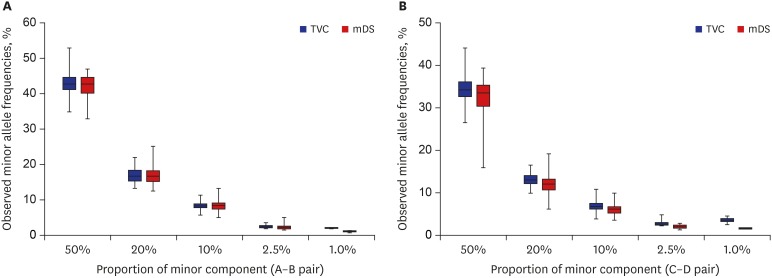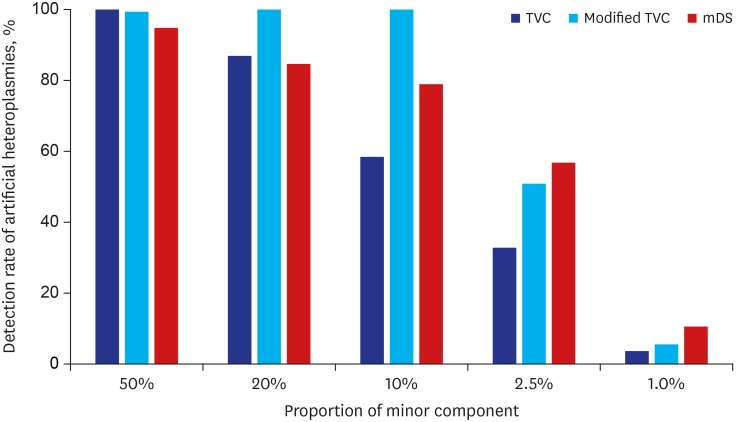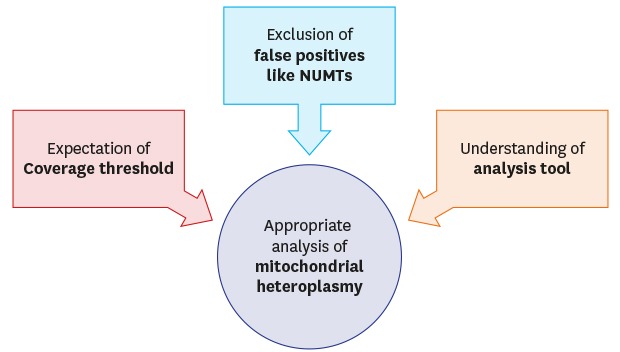1. Tuppen HA, Blakely EL, Turnbull DM, Taylor RW. Mitochondrial DNA mutations and human disease. Biochim Biophys Acta. 2010; 1797(2):113–128. PMID:
19761752.

2. Bianchi DW. Prenatal diagnostics: fetal genes in mother's blood. Nature. 2012; 487(7407):304–305. PMID:
22810690.
3. Perales-Clemente E, Cook AN, Evans JM, Roellinger S, Secreto F, Emmanuele V, et al. Natural underlying mtDNA heteroplasmy as a potential source of intra-person hiPSC variability. EMBO J. 2016; 35(18):1979–1990. PMID:
27436875.
4. Zhang J, Liu H, Luo S, Lu Z, Chávez-Badiola A, Liu Z, et al. Live birth derived from oocyte spindle transfer to prevent mitochondrial disease. Reprod Biomed Online. 2017; 34(4):361–368. PMID:
28385334.

5. Hyslop LA, Blakeley P, Craven L, Richardson J, Fogarty NM, Fragouli E, et al. Towards clinical application of pronuclear transfer to prevent mitochondrial DNA disease. Nature. 2016; 534(7607):383–386. PMID:
27281217.

6. Parson W, Gusmão L, Hares DR, Irwin JA, Mayr WR, Morling N, et al. DNA Commission of the International Society for Forensic Genetics: revised and extended guidelines for mitochondrial DNA typing. Forensic Sci Int Genet. 2014; 13:134–142. PMID:
25117402.

7. Ivanov PL, Wadhams MJ, Roby RK, Holland MM, Weedn VW, Parsons TJ. Mitochondrial DNA sequence heteroplasmy in the Grand Duke of Russia Georgij Romanov establishes the authenticity of the remains of Tsar Nicholas II. Nat Genet. 1996; 12(4):417–420. PMID:
8630496.

8. McFarland R, Clark KM, Morris AA, Taylor RW, Macphail S, Lightowlers RN, et al. Multiple neonatal deaths due to a homoplasmic mitochondrial DNA mutation. Nat Genet. 2002; 30(2):145–146. PMID:
11799391.

9. Just RS, Irwin JA, Parson W. Mitochondrial DNA heteroplasmy in the emerging field of massively parallel sequencing. Forensic Sci Int Genet. 2015; 18:131–139. PMID:
26009256.

10. Buermans HP, den Dunnen JT. Next generation sequencing technology: Advances and applications. Biochim Biophys Acta. 2014; 1842(10):1932–1941. PMID:
24995601.

11. Weissensteiner H, Forer L, Fuchsberger C, Schöpf B, Kloss-Brandstätter A, Specht G, et al. mtDNA-Server: next-generation sequencing data analysis of human mitochondrial DNA in the cloud. Nucleic Acids Res. 2016; 44(W1):W64-9. PMID:
27084948.

12. Skonieczna K, Malyarchuk B, Jawień A, Marszałek A, Banaszkiewicz Z, Jarmocik P, et al. Heteroplasmic substitutions in the entire mitochondrial genomes of human colon cells detected by ultra-deep 454 sequencing. Forensic Sci Int Genet. 2015; 15:16–20. PMID:
25465762.

13. Seneca S, Vancampenhout K, Van Coster R, Smet J, Lissens W, Vanlander A, et al. Analysis of the whole mitochondrial genome: translation of the Ion Torrent Personal Genome Machine system to the diagnostic bench? Eur J Hum Genet. 2015; 23(1):41–48. PMID:
24667782.

14. Kim H, Erlich HA, Calloway CD. Analysis of mixtures using next generation sequencing of mitochondrial DNA hypervariable regions. Croat Med J. 2015; 56(3):208–217. PMID:
26088845.

15. Guo Y, Li CI, Sheng Q, Winther JF, Cai Q, Boice JD, et al. Very low-level heteroplasmy mtDNA variations are inherited in humans. J Genet Genomics. 2013; 40(12):607–615. PMID:
24377867.

16. Cui H, Li F, Chen D, Wang G, Truong CK, Enns GM, et al. Comprehensive next-generation sequence analyses of the entire mitochondrial genome reveal new insights into the molecular diagnosis of mitochondrial DNA disorders. Genet Med. 2013; 15(5):388–394. PMID:
23288206.

17. Tang S, Huang T. Characterization of mitochondrial DNA heteroplasmy using a parallel sequencing system. Biotechniques. 2010; 48(4):287–296. PMID:
20569205.

18. Wei W, Keogh MJ, Wilson I, Coxhead J, Ryan S, Rollinson S, et al. Mitochondrial DNA point mutations and relative copy number in 1363 disease and control human brains. Acta Neuropathol Commun. 2017; 5(1):13. PMID:
28153046.

19. Zhou Y, Guo F, Yu J, Liu F, Zhao J, Shen H, et al. Strategies for complete mitochondrial genome sequencing on Ion Torrent PGM™ platform in forensic sciences. Forensic Sci Int Genet. 2016; 22:11–21. PMID:
26809045.

20. Triant DA, DeWoody JA. The occurrence, detection, and avoidance of mitochondrial DNA translocations in mammalian systematics and phylogeography. J Mammal. 2007; 88(4):908–920.

21. Parr RL, Maki J, Reguly B, Dakubo GD, Aguirre A, Wittock R, et al. The pseudo-mitochondrial genome influences mistakes in heteroplasmy interpretation. BMC Genomics. 2006; 7(1):185. PMID:
16859552.

22. Fendt L, Zimmermann B, Daniaux M, Parson W. Sequencing strategy for the whole mitochondrial genome resulting in high quality sequences. BMC Genomics. 2009; 10(1):139. PMID:
19331681.

23. Zaragoza MV, Fass J, Diegoli M, Lin D, Arbustini E. Mitochondrial DNA variant discovery and evaluation in human cardiomyopathies through next-generation sequencing. PLoS One. 2010; 5(8):e12295. PMID:
20808834.

24. Calabrese C, Simone D, Diroma MA, Santorsola M, Guttà C, Gasparre G, et al. MToolBox: a highly automated pipeline for heteroplasmy annotation and prioritization analysis of human mitochondrial variants in high-throughput sequencing. Bioinformatics. 2014; 30(21):3115–3117. PMID:
25028726.

25. Guo Y, Li J, Li CI, Shyr Y, Samuels DC. MitoSeek: extracting mitochondria information and performing high-throughput mitochondria sequencing analysis. Bioinformatics. 2013; 29(9):1210–1211. PMID:
23471301.

26. Clarke AC, Prost S, Stanton JA, White WT, Kaplan ME, Matisoo-Smith EA, et al. From cheek swabs to consensus sequences: an A to Z protocol for high-throughput DNA sequencing of complete human mitochondrial genomes. BMC Genomics. 2014; 15(1):68. PMID:
24460871.

27. Vellarikkal SK, Dhiman H, Joshi K, Hasija Y, Sivasubbu S, Scaria V. mit-o-matic: a comprehensive computational pipeline for clinical evaluation of mitochondrial variations from next-generation sequencing datasets. Hum Mutat. 2015; 36(4):419–424. PMID:
25677119.

28. Holland MM, Pack ED, McElhoe JA. Evaluation of GeneMarker
® HTS for improved alignment of mtDNA MPS data, haplotype determination, and heteroplasmy assessment. Forensic Sci Int Genet. 2017; 28:90–98. PMID:
28193506.
29. Mikkelsen M, Frank-Hansen R, Hansen AJ, Morling N. Massively parallel pyrosequencing of the mitochondrial genome with the 454 methodology in forensic genetics. Forensic Sci Int Genet. 2014; 12:30–37. PMID:
24879032.

30. Li M, Schönberg A, Schaefer M, Schroeder R, Nasidze I, Stoneking M. Detecting heteroplasmy from high-throughput sequencing of complete human mitochondrial DNA genomes. Am J Hum Genet. 2010; 87(2):237–249. PMID:
20696290.

31. Park S, Cho S, Seo HJ, Lee JH, Kim MY, Lee SD. Entire mitochondrial DNA sequencing on massively parallel sequencing for the Korean population. J Korean Med Sci. 2017; 32(4):587–592. PMID:
28244283.

32. Kiesler KM, Vallone PM. Characterization of NIST standard reference materials by next generation sequencing. Forensic Sci Int Genet Suppl Ser. 2013; 4(1):e97–8.

33. Kavlick MF, Lawrence HS, Merritt RT, Fisher C, Isenberg A, Robertson JM, et al. Quantification of human mitochondrial DNA using synthesized DNA standards. J Forensic Sci. 2011; 56(6):1457–1463. PMID:
21883207.

34. Dayama G, Emery SB, Kidd JM, Mills RE. The genomic landscape of polymorphic human nuclear mitochondrial insertions. Nucleic Acids Res. 2014; 42(20):12640–12649. PMID:
25348406.

35. Marquis J, Lefebvre G, Kourmpetis YA, Kassam M, Ronga F, De Marchi U, et al. MitoRS, a method for high throughput, sensitive, and accurate detection of mitochondrial DNA heteroplasmy. BMC Genomics. 2017; 18(1):326. PMID:
28441938.

37. Sobenin IA, Mitrofanov KY, Zhelankin AV, Sazonova MA, Postnov AY, Revin VV, et al. Quantitative assessment of heteroplasmy of mitochondrial genome: perspectives in diagnostics and methodological pitfalls. BioMed Res Int. 2014; 2014:292017. PMID:
24818137.









 PDF
PDF Citation
Citation Print
Print




 XML Download
XML Download